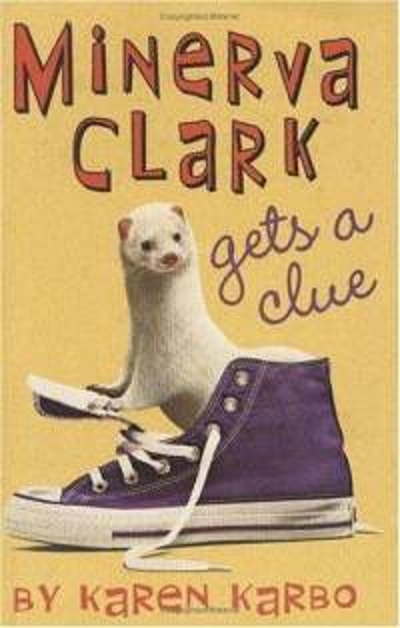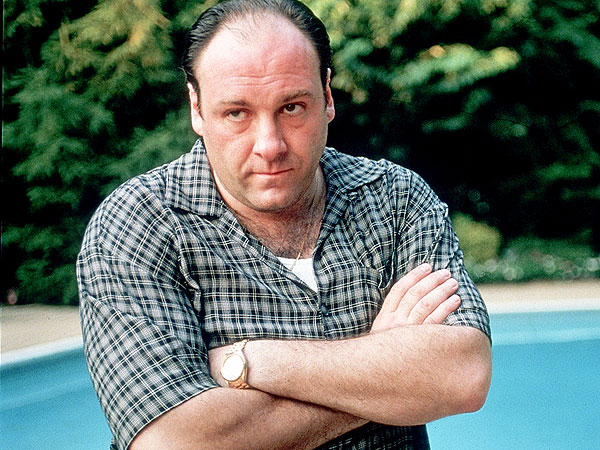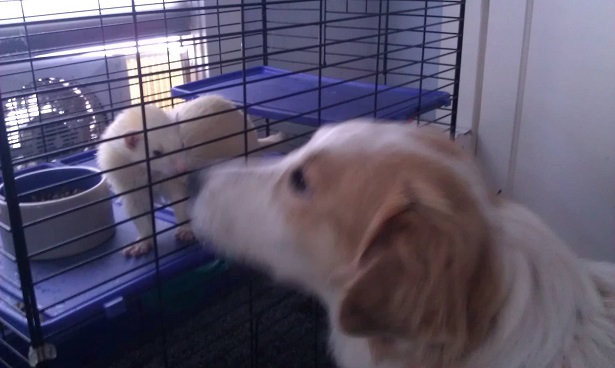It’s a sad day here in Karbohemia. Sid, the Official Minerva Clark Ferret, has died.
In 2005 I published the first in a trilogy of mysteries for middle grade readers starring a 7th grade girl detective called Minerva Clark. Every Sherlock Holmes must have a Watson, and Minerva’s was a white ferret named Jupiter, who traveled with her in the front pouch of her hoodie, and was trained to steal pieces of incriminating evidence that would help Minerva make her case. After the first book, Minerva Clark Gets a Clue, came out, I was invited to give presentations to grammar and middle schools, and it only seemed fitting that I arrive with my own ferret sidekick.
Ferrets are happiest in pairs, so my daughter, then in 8th grade, picked out Sid and Nancy at the local pet shop. We bought a little back pack meant for small dogs, and in it I carried them to schools and libraries all over the northwest. Nancy was shy and nippy, but Sid was the life of the party.
Sid and I had an act: I would stand in front of a long table while giving a natural history talk about ferrets (They were domesticated before cats and dogs; they are not rodents, but members of the weasel family; they are carnivores and also crepuscular — if you know what that means, raise your hand!). I’d leave my purse open behind me, and when I got to the part about how ferrets loved to steal shiny things, I put Sid on the table, turn back around, and continue my talk, pretending to be unaware that behind me Sid had found his way into my bag. He would root around frantically, before emerging with a tube of lip gloss with its shiny cap. The kids roared and shrieked with laughter. Sid was a star.
Ferrets are prone to a number of weird diseases. Nancy died young of juvenile lymphoma, and we replaced her with a mated pair, Ozzie and Harriet. Ozzie, at about age 4, suffered an intestinal infarction and Harriet died in her sleep a few months later.
But Sid lived on. His favorite occupation was stealing the insoles of our shoes and hiding them under the sofa. He methodically absconded with the dog’s toys. A plastic cheeseburger twice his size was a favorite. He also never said no to a flip flop. He lived in a seven foot tall “condo,” where he slept in a fleece-lined hammock. His preferred treat was a piece of thigh from a rotisserie chicken, which I would feed him most mornings before I sat down to write.
At age five he started to slow down a little; when you entered the room, if he was out of his condo for play time, he would no longer leap on your pant leg like Spiderman. We assumed he was in his twilight years. Then he survived a surgery for an intestinal blockage. Then he survived a fall out of a second floor window (he’d clambered up a chair and over the sill). He turned seven. Now he was really old. The vet marveled. We all clucked that it was too bad he’d been neutered; those Sid genes should have been passed on.
It seemed likely he would live forever. Then, last week, a month before his eighth birthday, I found him at the bottom of his condo, in his litter box, blind and trembling, his neck arched back at an unnatural angle, an apparent stroke. He was clearly gone, but when I picked him up, his heart still beat strong.
A day later, after he had been euthanized and the vet made a clay print of his tiny paw, a nicety usually reserved for dogs and cats, this essay appeared in the New York Times. Called “The Trauma of Being Alive” its bleak message (surprising, given that essayists writing for mainstream publications are usually pressed into injecting at least a little uplift into the gloom and doom) is that every life is chock full of loss. Furthermore, if that’s not depressing enough, every loss provides not only its own bitch slap of trauma, but also further flattens you by dredging up all the other losses that have gone before.
The loss of a pet is thus a reminder of all the other losses you’ve absorbed: the death of your mother and/or father; the marriage that didn’t work out; the sweet child that is now a surly new adult; the sleek bod that used to rock that white bikini; the sudden demise of James Gandolfini, who it turns out we loved beyond all reason.
What does this have to do with the title of this post, Rule #3, Learn to Be Amused?
(Excellent question. I simply felt the need to commemorate Sid. Now we will return to our regular programming.)
Julia Child, despite her glorious life of love, fame, fortune, and cooking with abandon (with butter), suffered her share. Her mother perished of untreated high blood pressure when Julia was in her early 20s, and the health of her beloved Paul began to fail just as “The French Chef” took off, and they were preparing to bask in a life of success and good fortune. As she barreled into old age, her friends began to “slip off the raft,” as she liked to call it. First James Beard, then Simone Beck.
But Julia possessed the gift of finding life amusing. It was a fundamental component of her optimism. Just because things weren’t going well, or even when she was in the midst of grief, she could be cheered, at least momentarily, by the discovery of a new cooking technique, a letter from a friend, travel. Even enjoying a hot dog at Costco could lift her spirits. Life may be loss, but most of the time, right before our very eyes and right this minute, there is something amusing, something that can comfort us, if only for a few moments. And since life is also made of moments, it’s good to learn to be amused.
In 1978, Saturday Night Live did a send-up of “The French Chef,” with Dan Aykroyd. Julia kept a copy of the video in a drawer beneath her kitchen counter, and whenever she needed a good laugh, she popped it in the VCR.
I’m going to watch it now, and you should too. (Warning: contains some really fake blood.)
sources: James Gandolfini, photographer Anthony Neste/Time Life Pictures/Getty/www.people.com; “The French Chef,” www.YouTube.com












Thanks for this! I’m experience out-sized sadness today since I learned a nearby shop is closing. It specialized in local foods and was more source for local chicken, among other things. It was nice to be reminded that grief happens and has unpredictable connections. Loved the video.
Thanks so much, Joy. I think sometimes we feel a little silly being sad at losing something that doesn’t seem “big.” The heart is so mysterious. Be well (and stay amused.)
Karen, I’m so sorry for your lose of Sid. Pets make us better humans. In my imagination I could just see that scamp, Sid, stealing the shiny lipstick from your purse and making the kids laugh. I was a teacher for so long and really miss all those special assemblies. Thanks for including Tony Soprano and Julia and reminding us of the universal truth regarding misfortune, heartbreak and then finding something amusing despite it all.
Keep writing.
Thank you, JoAnn.
Also for your observation that “pets make us better humans,” They do help us know what it’s like to experience unconditional love, that’s for sure.